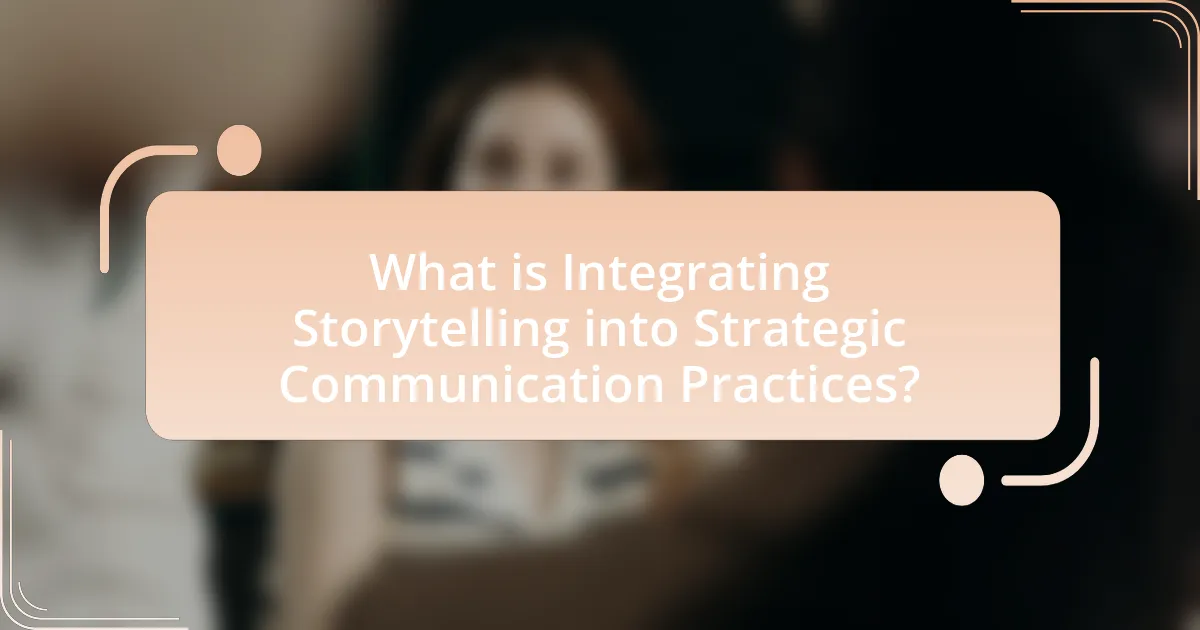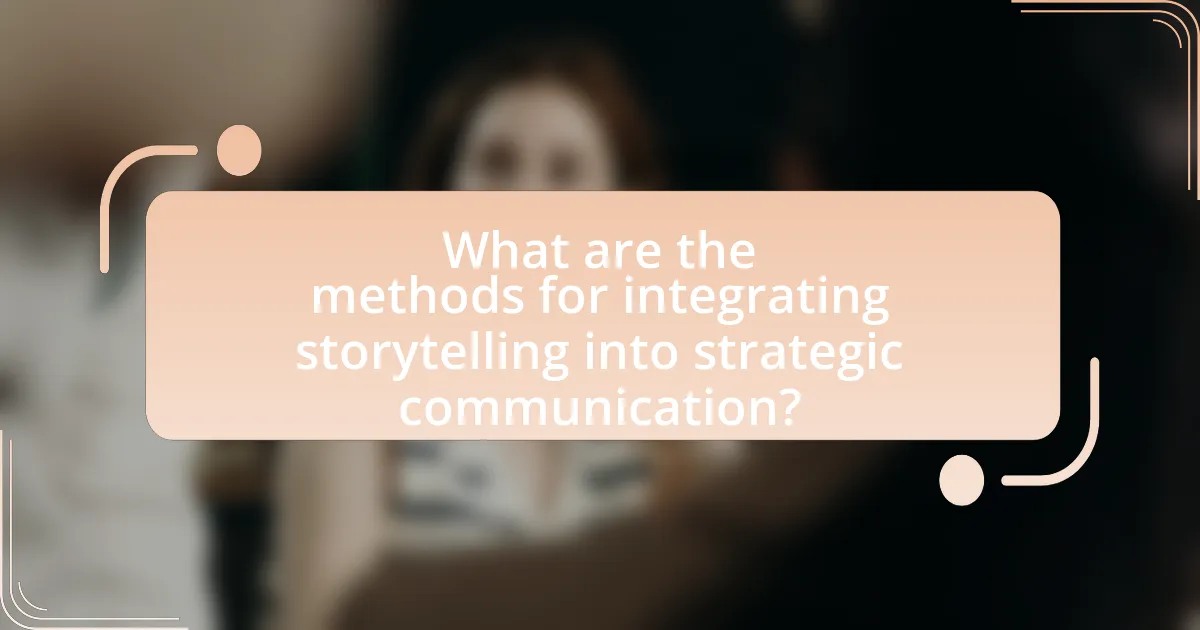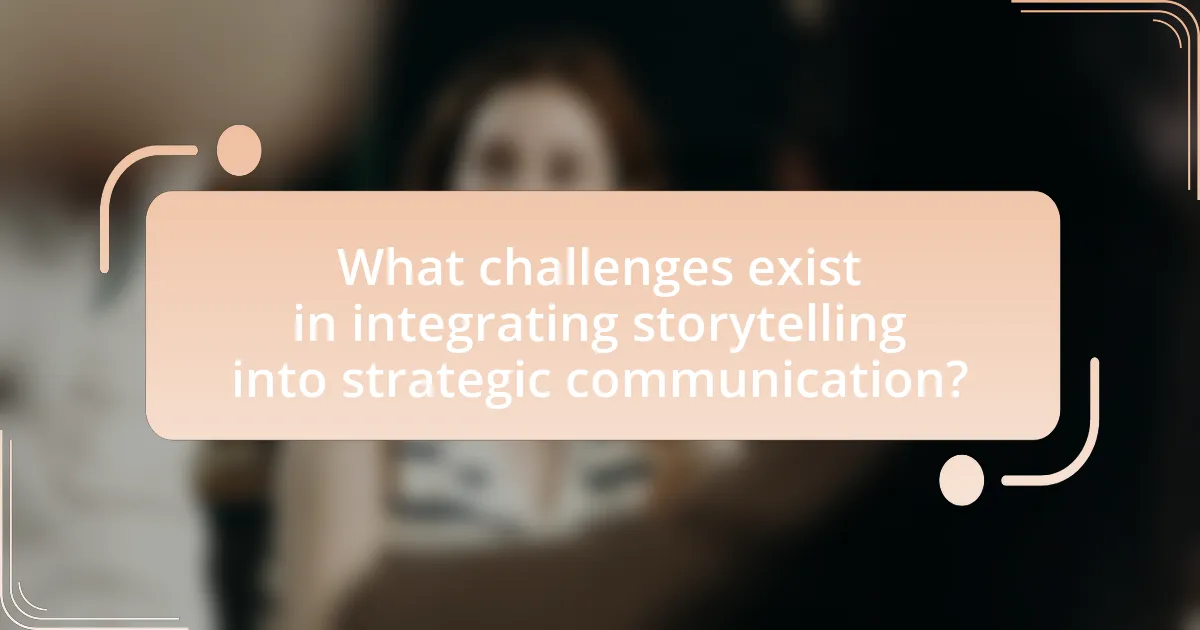Integrating storytelling into strategic communication practices involves utilizing narrative techniques to effectively convey messages and engage audiences. This approach enhances emotional connections, improves information retention by up to 65%, and allows organizations to communicate complex ideas in relatable ways. Key elements of storytelling include characters, conflict, resolution, and a clear message, which collectively foster audience engagement and understanding. The article also explores methods for developing a storytelling strategy, the psychological effects of narratives, and best practices for ensuring authenticity and effectiveness in communication. Additionally, it addresses challenges organizations may face in implementing storytelling and offers metrics for evaluating its impact.

What is Integrating Storytelling into Strategic Communication Practices?
Integrating storytelling into strategic communication practices involves using narrative techniques to convey messages effectively and engage audiences. This approach enhances the emotional connection between the communicator and the audience, making information more relatable and memorable. Research indicates that stories can improve retention of information by up to 65% compared to facts alone, as demonstrated in studies by the Stanford Graduate School of Business. By weaving narratives into communication strategies, organizations can foster a deeper understanding of their values, missions, and goals, ultimately leading to more impactful engagement and persuasion.
How does storytelling enhance strategic communication?
Storytelling enhances strategic communication by creating emotional connections that engage audiences more effectively than traditional messaging. This engagement is crucial because research indicates that narratives can increase information retention by up to 65% compared to non-narrative formats. Furthermore, storytelling allows organizations to convey complex ideas in a relatable manner, making it easier for audiences to understand and remember key messages. For instance, a study published in the Journal of Business Communication found that companies using storytelling in their communication strategies experienced a 20% increase in audience engagement metrics. Thus, storytelling serves as a powerful tool in strategic communication by fostering connection, enhancing understanding, and improving retention of information.
What are the key elements of storytelling in communication?
The key elements of storytelling in communication are characters, conflict, resolution, and a clear message. Characters engage the audience by providing relatable figures, while conflict introduces tension that drives the narrative forward. Resolution offers closure, allowing the audience to reflect on the story’s message, which should be clear and impactful. Research by the Harvard Business Review highlights that stories with these elements are more memorable and persuasive, demonstrating their effectiveness in strategic communication practices.
How does storytelling influence audience engagement?
Storytelling significantly enhances audience engagement by creating emotional connections and fostering relatability. When narratives are employed, they allow audiences to immerse themselves in experiences, making the content more memorable and impactful. Research indicates that stories activate multiple areas of the brain, leading to increased empathy and understanding; for instance, a study published in the journal “Neuroscience” found that storytelling can stimulate brain activity in ways that factual information does not. This heightened engagement results in improved retention of information and a greater likelihood of audience action, as evidenced by marketing campaigns that utilize storytelling techniques, which have shown to increase conversion rates by up to 30%.
Why is storytelling important in strategic communication?
Storytelling is important in strategic communication because it enhances engagement and retention of information. When narratives are used, they create emotional connections that make messages more relatable and memorable. Research indicates that stories can increase information retention by up to 65% compared to facts alone, as demonstrated in studies by the NeuroLeadership Institute, which found that storytelling activates multiple areas of the brain, leading to better understanding and recall. This effectiveness in communication is crucial for organizations aiming to influence behavior and foster relationships with their audiences.
What psychological effects does storytelling have on audiences?
Storytelling has significant psychological effects on audiences, primarily by enhancing emotional engagement and fostering empathy. When individuals are exposed to narratives, their brains activate in ways that mirror the experiences of characters, leading to a deeper emotional connection. Research indicates that stories can stimulate the release of oxytocin, a hormone associated with bonding and empathy, which enhances the audience’s ability to relate to the characters and their situations. For instance, a study by Paul Zak published in the journal “PLOS ONE” found that participants who engaged with a compelling story showed increased oxytocin levels, suggesting that storytelling can effectively promote social connection and understanding. Additionally, storytelling can influence attitudes and behaviors by creating memorable experiences that resonate on a personal level, making the conveyed messages more impactful.
How does storytelling differentiate brands in communication?
Storytelling differentiates brands in communication by creating emotional connections that resonate with audiences. This approach allows brands to convey their values, mission, and personality in a relatable manner, making them more memorable. For instance, a study by the Harvard Business Review found that stories are 22 times more memorable than facts alone, highlighting the effectiveness of storytelling in enhancing brand recall. By engaging consumers on an emotional level, brands can foster loyalty and trust, ultimately leading to a competitive advantage in the marketplace.

What are the methods for integrating storytelling into strategic communication?
The methods for integrating storytelling into strategic communication include narrative framing, audience engagement, and emotional resonance. Narrative framing involves structuring communication around a central story that aligns with the organization’s values and objectives, making the message more relatable and memorable. Audience engagement is achieved by tailoring stories to the specific interests and experiences of the target audience, which enhances connection and relevance. Emotional resonance is created by incorporating elements that evoke feelings, thereby fostering a deeper connection with the audience and increasing the likelihood of message retention. These methods are supported by research indicating that stories can significantly enhance information retention and engagement, as evidenced by studies showing that narratives are processed differently in the brain compared to factual information, leading to improved understanding and recall.
How can organizations develop a storytelling strategy?
Organizations can develop a storytelling strategy by identifying their core message and audience, then crafting narratives that resonate with that audience. This involves understanding the values and emotions of the target demographic, which can be achieved through market research and audience analysis. For instance, a study by the Harvard Business Review found that stories are 22 times more memorable than facts alone, highlighting the importance of narrative in communication. By integrating personal anecdotes, customer testimonials, and brand history into their storytelling, organizations can create authentic connections that enhance engagement and loyalty.
What steps are involved in creating a compelling narrative?
Creating a compelling narrative involves several key steps: defining the core message, understanding the audience, structuring the story, incorporating emotional elements, and refining the narrative.
Firstly, defining the core message establishes the central theme or takeaway that the narrative will convey. This clarity ensures that the story remains focused and impactful. Secondly, understanding the audience allows the storyteller to tailor the narrative to resonate with the specific interests, values, and experiences of the target demographic, enhancing engagement.
Next, structuring the story involves organizing the content into a coherent format, typically including a beginning that introduces the characters and setting, a middle that presents the conflict or challenge, and an end that resolves the story and reinforces the core message. Incorporating emotional elements is crucial, as narratives that evoke feelings tend to be more memorable and persuasive; research shows that emotional storytelling can increase retention and influence decision-making.
Finally, refining the narrative through editing and feedback ensures clarity, coherence, and impact, allowing the storyteller to polish the message and enhance its effectiveness. These steps collectively contribute to the creation of a compelling narrative that effectively integrates storytelling into strategic communication practices.
How can organizations align storytelling with their communication goals?
Organizations can align storytelling with their communication goals by clearly defining their objectives and tailoring narratives that resonate with their target audience. This involves identifying key messages that support the organization’s mission and values, ensuring that stories reflect these elements authentically. For instance, a study by the Harvard Business Review highlights that companies that effectively use storytelling can increase engagement and retention by up to 65%. By integrating data and emotional appeal into their narratives, organizations can create compelling stories that not only inform but also inspire action, thereby achieving their communication goals more effectively.
What tools and platforms can facilitate storytelling in communication?
Tools and platforms that facilitate storytelling in communication include social media platforms, video editing software, presentation tools, and content management systems. Social media platforms like Instagram and Facebook allow users to share visual stories and engage audiences through multimedia content. Video editing software such as Adobe Premiere Pro and Final Cut Pro enable the creation of compelling narratives through video. Presentation tools like PowerPoint and Prezi help structure and deliver stories effectively in professional settings. Content management systems like WordPress and Medium provide a platform for publishing written stories, allowing for easy sharing and audience interaction. These tools enhance the storytelling process by providing diverse formats and channels for communication, thereby increasing audience engagement and retention.
Which digital platforms are most effective for storytelling?
Social media platforms, particularly Instagram, Facebook, and TikTok, are the most effective for storytelling. These platforms enable visual and narrative engagement, allowing users to share stories through images, videos, and text. For instance, Instagram’s emphasis on visual content has led to a 58% higher engagement rate for brands that utilize storytelling techniques. Facebook’s diverse content formats, including live videos and stories, facilitate real-time interaction and deeper connections with audiences. TikTok’s short-form video format encourages creativity and immediacy, making it ideal for capturing attention and conveying messages quickly. These platforms collectively enhance storytelling by leveraging user-generated content, community interaction, and multimedia capabilities, making them essential tools in strategic communication practices.
How can multimedia enhance storytelling in communication?
Multimedia enhances storytelling in communication by integrating various formats such as text, images, audio, and video, which collectively create a more engaging and immersive experience for the audience. This integration allows for the conveyance of complex narratives in a more accessible manner, as studies show that people retain information better when it is presented through multiple sensory channels. For instance, research by the University of California found that multimedia presentations can improve retention rates by up to 50% compared to traditional text-only formats. By appealing to different learning styles and preferences, multimedia not only captures attention but also fosters emotional connections, making the storytelling more impactful and memorable.

What challenges exist in integrating storytelling into strategic communication?
Integrating storytelling into strategic communication faces several challenges, including the difficulty of aligning narratives with organizational goals. Organizations often struggle to create stories that resonate with diverse audiences while maintaining brand consistency. Additionally, measuring the effectiveness of storytelling in achieving communication objectives poses a significant challenge, as traditional metrics may not adequately capture the impact of narrative-driven approaches. Research indicates that 70% of marketers find it challenging to create content that engages their audience, highlighting the need for effective storytelling strategies that can bridge this gap.
What common pitfalls should organizations avoid?
Organizations should avoid the pitfall of neglecting audience engagement when integrating storytelling into strategic communication practices. Failing to understand the audience’s needs and preferences can lead to ineffective messaging and disconnection from the target demographic. Research indicates that 70% of consumers prefer brands that tell stories, highlighting the importance of aligning narratives with audience interests to foster connection and loyalty. Additionally, organizations should steer clear of overcomplicating their stories; clarity and simplicity are crucial for effective communication. Studies show that clear messaging increases retention rates by up to 80%, emphasizing the need for straightforward narratives. Lastly, organizations must avoid inconsistency in their storytelling across different platforms, as brand inconsistency can confuse audiences and diminish trust. Consistent messaging is linked to a 23% increase in revenue, underscoring the importance of a unified narrative strategy.
How can organizations ensure authenticity in their storytelling?
Organizations can ensure authenticity in their storytelling by prioritizing transparency and aligning narratives with core values. This involves sharing genuine experiences and insights from real stakeholders, which fosters trust and relatability. For instance, a study by the Harvard Business Review highlights that brands that communicate their values authentically see a 33% increase in customer loyalty. By actively engaging with their audience and incorporating feedback, organizations can create narratives that resonate deeply and reflect true experiences, thereby enhancing authenticity.
What strategies can mitigate the risk of miscommunication?
To mitigate the risk of miscommunication, organizations can implement clear communication protocols, utilize active listening techniques, and encourage feedback loops. Clear communication protocols establish guidelines for information sharing, ensuring that messages are concise and unambiguous. Active listening techniques, such as paraphrasing and summarizing, help confirm understanding and clarify any uncertainties. Feedback loops, where recipients are encouraged to ask questions and provide input, foster an environment of open dialogue, reducing the likelihood of misunderstandings. Research indicates that organizations with structured communication practices experience 25% fewer miscommunication incidents, highlighting the effectiveness of these strategies.
How can organizations measure the effectiveness of storytelling in communication?
Organizations can measure the effectiveness of storytelling in communication through various metrics such as audience engagement, retention rates, and feedback surveys. Audience engagement can be quantified by analyzing social media interactions, website traffic, and participation in storytelling events, which indicate how well the story resonates with the audience. Retention rates can be assessed by tracking how many individuals recall the story or its key messages over time, often through follow-up surveys or quizzes. Feedback surveys provide direct insights into audience perceptions and emotional responses to the storytelling, allowing organizations to gauge the impact and effectiveness of their narratives. These methods collectively offer a comprehensive view of storytelling effectiveness in communication strategies.
What metrics are useful for evaluating storytelling impact?
Useful metrics for evaluating storytelling impact include audience engagement, emotional response, message retention, and conversion rates. Audience engagement can be measured through social media shares, comments, and likes, indicating how well the story resonates with the audience. Emotional response can be assessed using surveys or sentiment analysis tools to gauge feelings elicited by the story. Message retention is often evaluated through recall tests or follow-up surveys, determining how well the audience remembers key points. Conversion rates track the effectiveness of storytelling in driving desired actions, such as purchases or sign-ups, providing a clear link between storytelling and business outcomes. These metrics collectively offer a comprehensive view of storytelling effectiveness in strategic communication.
How can feedback be utilized to improve storytelling practices?
Feedback can be utilized to improve storytelling practices by providing insights into audience engagement and comprehension. When storytellers gather feedback through surveys, focus groups, or audience reactions, they can identify which elements resonate most effectively and which aspects may confuse or disengage the audience. For instance, a study by the Nielsen Norman Group found that user feedback significantly enhances narrative clarity and emotional impact, leading to more compelling stories. By analyzing this feedback, storytellers can refine their narratives, adjust pacing, and enhance character development, ultimately creating more impactful and relatable stories.
What are best practices for successful storytelling in strategic communication?
Best practices for successful storytelling in strategic communication include understanding the audience, crafting a clear and compelling narrative, and utilizing emotional engagement. Understanding the audience allows communicators to tailor messages that resonate, ensuring relevance and impact. A clear narrative structure, often following the classic arc of beginning, middle, and end, helps maintain focus and clarity, making the message easier to follow. Emotional engagement is crucial, as stories that evoke feelings can enhance retention and motivate action. Research indicates that emotionally charged stories are 22 times more memorable than facts alone, highlighting the effectiveness of this approach in strategic communication.
How can organizations create relatable and impactful stories?
Organizations can create relatable and impactful stories by focusing on authentic experiences that resonate with their audience. This involves understanding the audience’s values, emotions, and challenges, allowing organizations to craft narratives that reflect shared experiences. For instance, a study by the Harvard Business Review found that stories that evoke emotions can increase engagement and retention by up to 65%. By incorporating real-life examples and testimonials, organizations can enhance credibility and relatability, making their stories more compelling and memorable.
What role does audience analysis play in effective storytelling?
Audience analysis is crucial for effective storytelling as it enables storytellers to tailor their narratives to resonate with specific groups. By understanding the demographics, preferences, and values of the audience, storytellers can craft messages that engage and connect on a deeper level. Research indicates that narratives aligned with audience interests lead to higher retention and emotional impact, as evidenced by a study published in the Journal of Communication, which found that tailored stories increased audience engagement by 30%. Thus, audience analysis directly influences the effectiveness of storytelling by ensuring relevance and relatability.